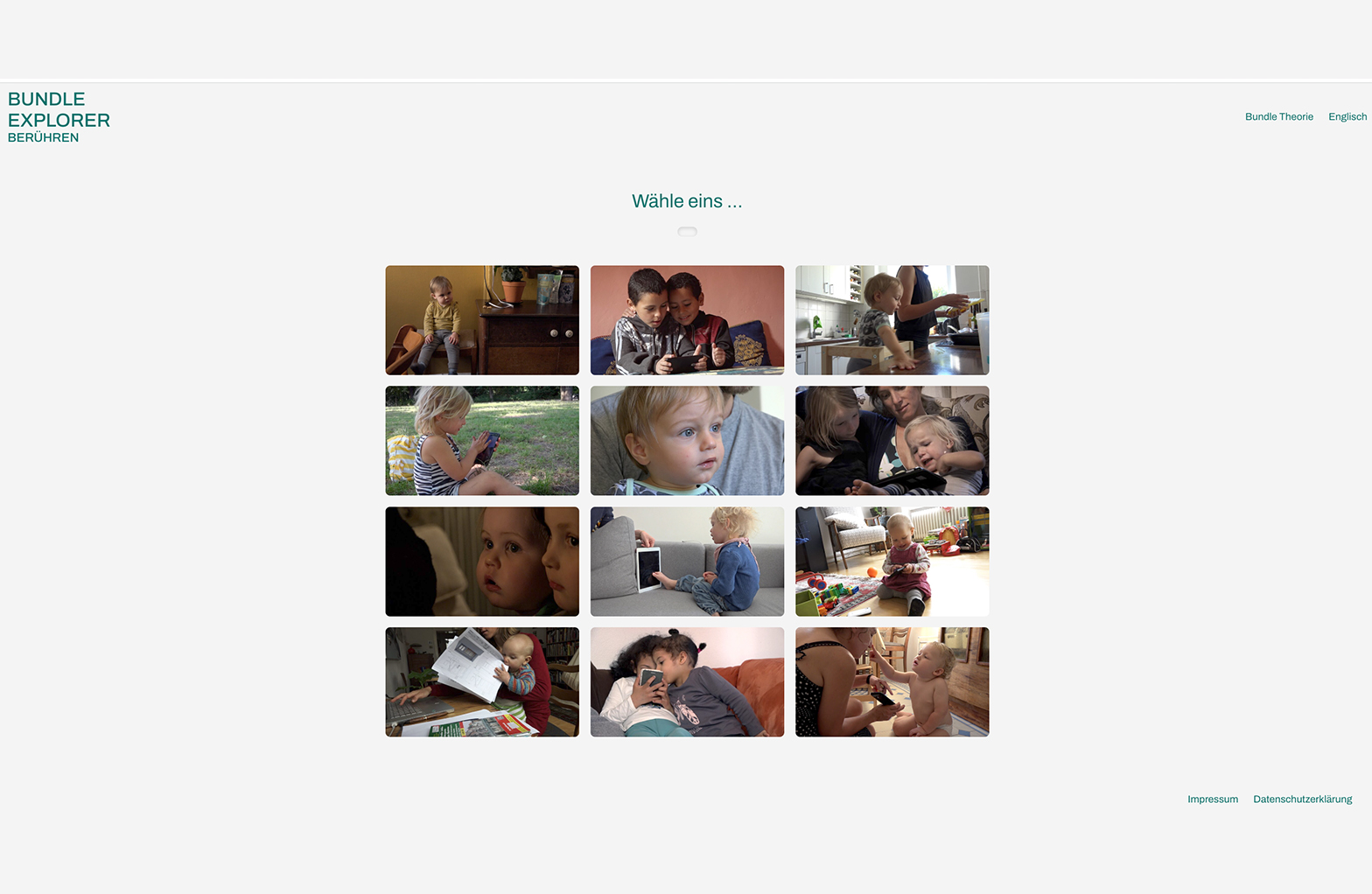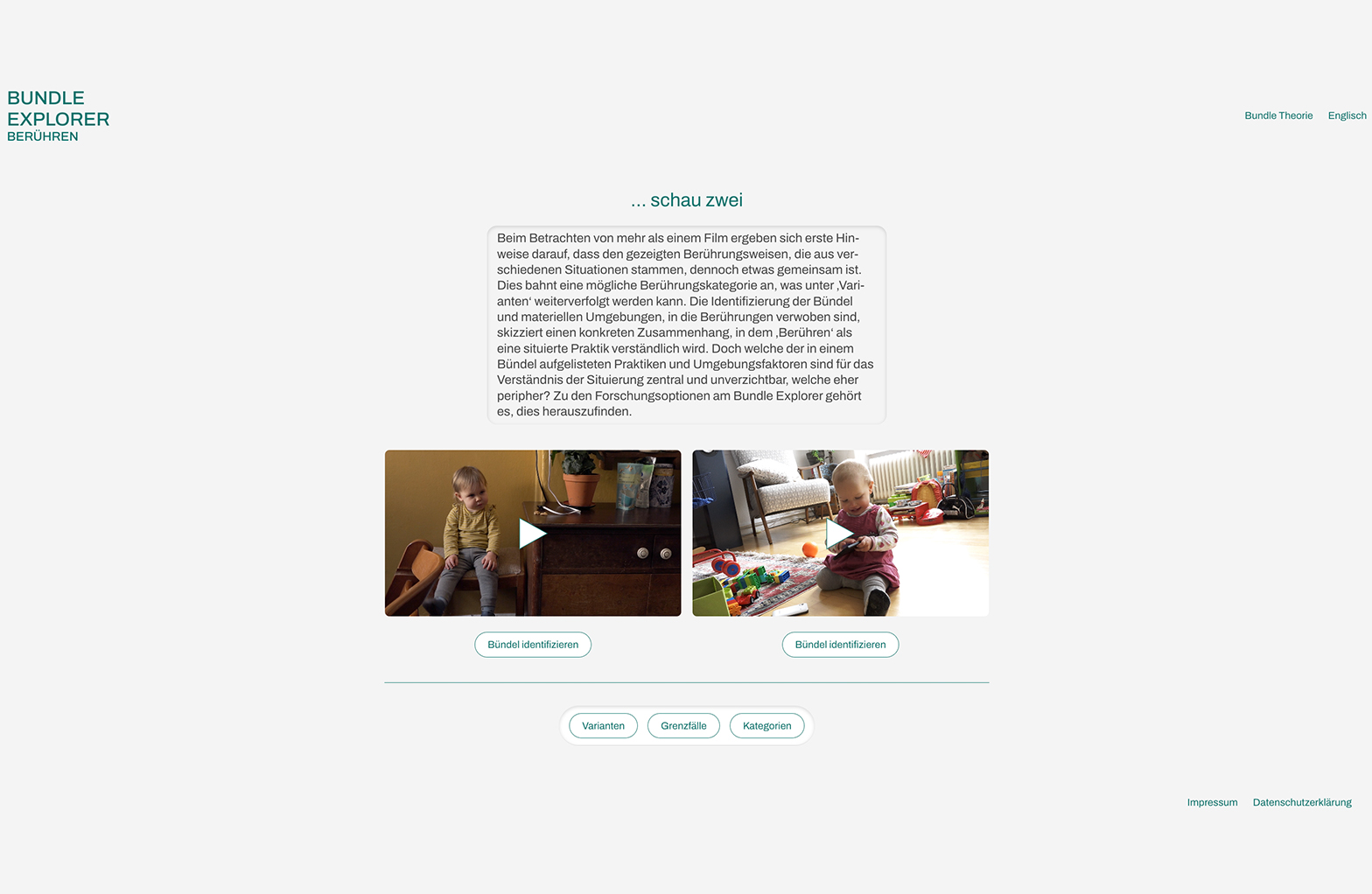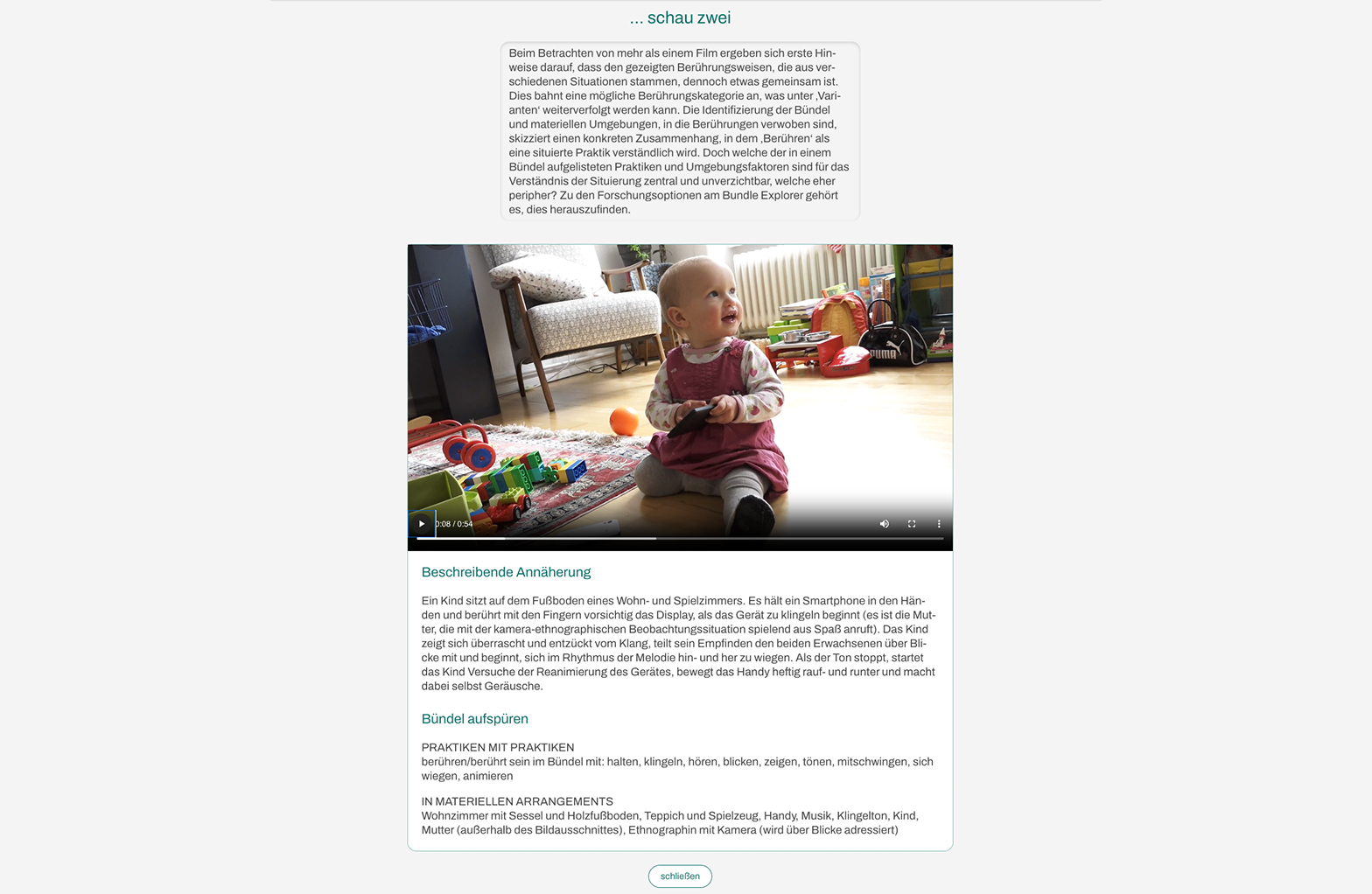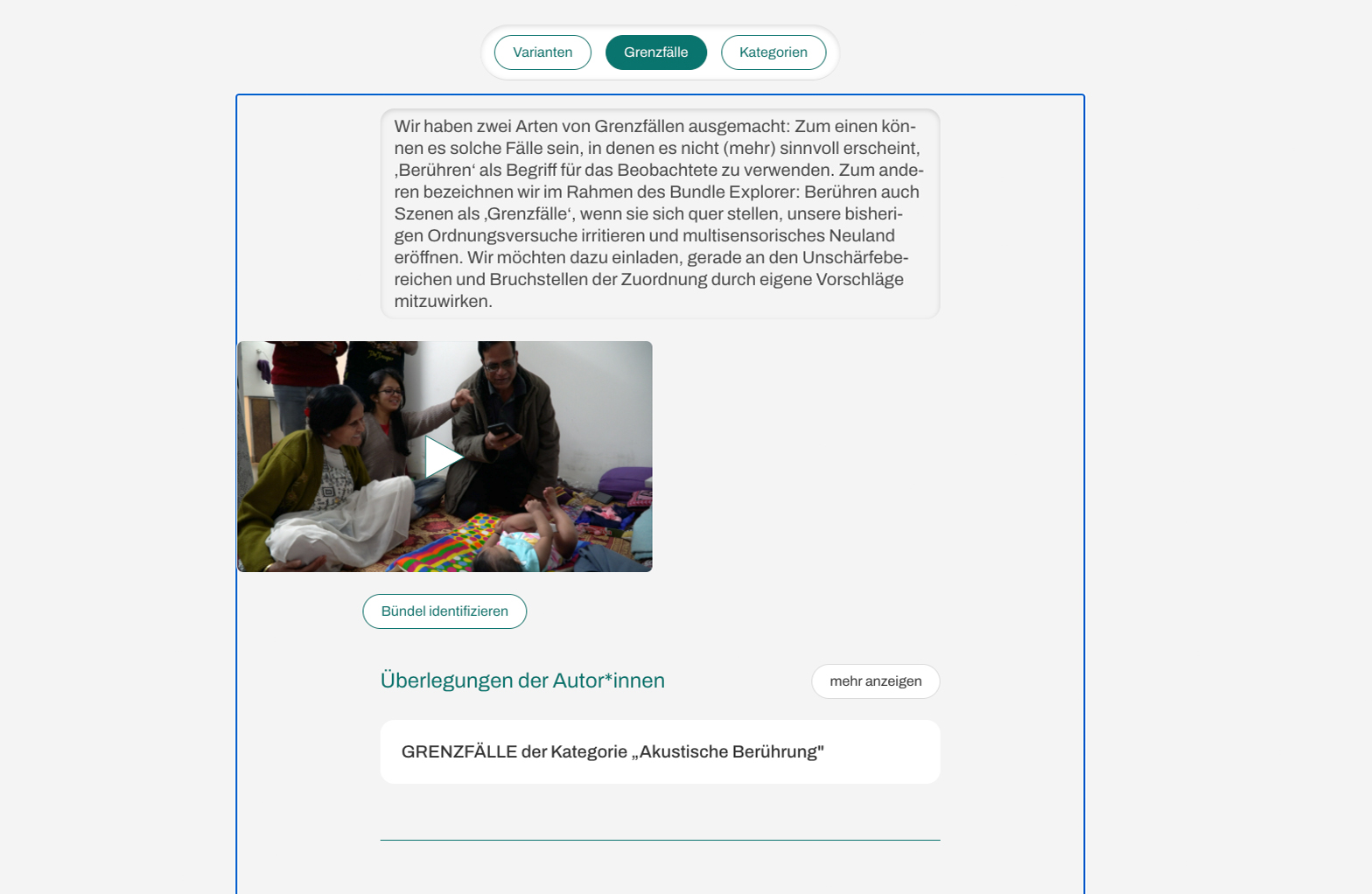Recap of the Blicklabor “Berührung”
Exploring the new multimedia research tool “Bundle Explorer: Berühren”
with Bina E. Mohn (Center for Camera Ethnography, Berlin) and Astrid Vogelpohl (University of Siegen)
Last December, the CRC researchers from project B05 presented their self-developed new research platform, the “Bundle Explorer”, to the research community. During a one-day workshop, they discussed how to use this tool and tested new exploration paths and ways of thinking. With the Bundle Explorer, the researchers are making an important contribution to the development of practice-theoretical methods at the CRC.
About the research platform Bundle Explorer
The Bundle Explorer is a multimedia research platform developed by Bina E. Mohn, Astrid Vogelpohl and Pip Hare. With this research tool, the team aims to contribute to the understanding of situated sensory practices in digitized everyday worlds.
The researchers developed the platform as part of their camera ethnographic research on sensory practices in digital childhood. Their methodology was based on Ludwig Wittgenstein and his language game approach. With the Bundle Explorer, short films can be played back and the sensory practices they reveal can be examined more closely. The name Bundle Explorer refers to Theo Schatzki’s theory (2016) that human action and sensory practices and the environments in which they take place form bundles. As suggested by Schatzki, the Bundle Explorer can be used to examine these bundles more closely and understand them better.
The “Bundle Explorer: Berühren” presented in the Blicklabor “Berührung” is the prototype of the new research tool. With this prototype, we researchers can discover and explore situations and ways of touching in digital childhood in a variety of ways.
The “Bundle Explorer: Berühren” is based on 60 short films from six years of camera-ethnographic research observations on the everyday family life of young children. The films were ‘edited’ from many hours of video material and show in particular moments of touch. In the Bundle Explorer, these films are divided into six categories of touch, which reflect the diversity of forms of touch in young children’s everyday digital lives:
acoustic touch
immersive touch
body touch
thing touch
gestural touch
Display touch
These categories allow Bundle Explorer users to explore the films in their own way.
About the Blicklabor „Berührung“

For the camera ethnography, Blicklabore refers to encounters , „Blicke als Blicke zu reflektieren und in konkreten Forschungszusammenhängen damit zu experimentieren“ (Mohn 2023, S. 198).
The B05 project team invited the Wittgenstein expert Birgit Griesecke, the science sociologist Klaus Amann and the educational scientist Jochen Lange to the Blicklabor alongside an interested specialist audience. The Blicklabor took place on December 13 at the University of Siegen (→ to the event) and offered the opportunity to get to know the „Bundle Explorer: Berührung“ in more detail and try it out in a workshop phase. While exploring the Bundle Explorer, the participants were encouraged to watch the films, track down, compare and classify children’s sensory practices and examine classifications, variants and borderline cases. The participants then discussed their individual explorations and impressions.
About the „Bundle Explorer: Berühren“ using the example of the category „acoustic touch“
The category “acoustic touch” is one of six touch categories that are explored in the “Bundle Explorer: Berühren” video material. The acoustic aspect of touch plays a special role in the films in the acoustic touch category. When selecting and compiling the films, researchers were interested in how acoustic touch can be applied and contoured.
Users end up in this category rather by chance: After selecting a video in the start tableau (image 1), the tool offers them a compilation of two film scenes (image 2) that are not yet named according to any category: In the first video, a 2-year-old child listens to music with an MP3 player; in the second video, a toddler explores a smartphone and is surprised by the ringtone melody. Descriptive approaches are used to identify bundles of practices and their material arrangements (Fig. 3) and the question arises as to what these films have in common.
The Bundle Explorer then invites users to explore further “variations” (image 4) and “borderline cases” (image 5) of acoustic touches. The variants include videos in which one child makes a squeaking noise with a balloon, another makes his voice vibrate and another sings with his grandmother on his cell phone (image 4). As borderline cases, the Bundle Explorer offers videos in which touching is not clearly recognizable. For example, in the video in which the adult acts acoustically but the child does not react (image 5).
All these cases serve to better understand acoustic touch in children. The researchers are particularly interested in how children are touched by the respective sounds. Based on the videos, the researchers identified three types of acoustic touch in which touching and being touched is shown through:
Music, movement and dance
Voices, conversation and singing
Noise, experiment and improvisation
However, the video material in the Bundle Explorer not only invites you to explore the questions of how acoustic touch manifests itself in children and what triggers it. The videos also invite us to imagine other forms of touch that have not yet been filmed.
About the expert contributions
The invited experts emphasized the innovative content of the research platform, which allows new approaches to sensory experiences and enables an in-depth examination of research questions relating to human sensory and action practices.
The Bundle Explorer is an important tool for praxeological research, allowing non-verbal gestures and actions to be examined from a visual perspective. With the Blicklabor, the research team has also created a convincing event format that allows a critical examination of non-verbal sensory practices and brings researching gazes and gaze differences to bear.
Similar to an Alpenföhn, as Birgit Griesecke emphasized, the Bundle Explorer brings spectacular distant views closer for a limited period of time. However, the perceptible proximity – in her comparison of the mountains – also brings with it euphoria, headaches and dizziness (after the mountains). In her opinion, it is crucial in research on sensory practices to keep the experiences present in such a way that they can be integrated into the research. For further development, she suggests including touch in research beyond everyday digital family life. This would bring the relationship between touch and digitality into focus in even greater detail.
Jochen Lange compared the Bundle Explorer to a ‘Findemaschine’ or a ‘Findespiel’, that moves between publication and research tool. For him, the function and meaning of touch represent alternative approaches with which sensory practices can be further explored with the help of the Bundle Explorer.
For Klaus Amann, the Bundle Explorer has an experimental character that opens up reflective moments and allows new insights. According to him, touch should also be questioned critically under the conditions of the digital world.
Together with the participants, the experts made numerous suggestions for advancing research into digital sensory practices and further work on the Bundle Explorer. Their suggestions included looking at sensory practices in the context of “atmospheres”, including visual touch, taking resonance into account when analyzing touch and not seeing touching and being touched as necessarily related characteristics of touch.
The B05 research team would like to thank all participants for the critical and inspiring exchange!
The link to the “Bundle Explorer: Berühren” as well as the template for creating your own Bundle Explorer (de/en) are available on request from Astrid Vogelpohl.
References
Bina E. Mohn (2023): Kamera-Ethnographie – Ethnographische Forschung im Modus des Zeigens. Transcript.
Theodore R. Schatzki (2016): Praxistheorie als flache Ontologie. In: Praxistheorie. Ein soziologisches Forschungsprogramm. Transcript, S. 29-44.
Birgit Griesecke & Werner Kogge (2022): Mit Wittgenstein arbeiten. Ein Methoden Manual, Working Paper Series Collaborative Research Center 1187 Media of Cooperation, No. 24.
About the B05 research team
The project B05 „(Early) Childhood and Smartphone. Family Interaction Order, Learning Processes and Cooperation” examines sensory practices in digital childhoods and makes a fundamental contribution to understanding the cooperative constitution of the human and technical sensorium.
Astrid Vogelpohl is a researcher and conducts camera-ethnographic research on subjectivation practices in everyday digital family life.
Bina E. Mohn was a researcher in B05 until the end of 2023. She researches reflexive ethnography, visual anthropology and media. She is an expert for camera ethnography: kamera-ethnographie.de




